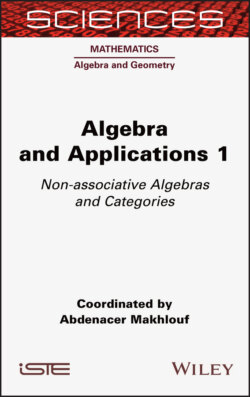Читать книгу Algebra and Applications 1 - Abdenacer Makhlouf - Страница 32
2.3. Unital composition algebras
ОглавлениеComposition algebras constitute a generalization of the classical algebras of the real, complex, quaternion and octonion numbers.
A quadratic form n : on a vector space V over a field is said to be non-degenerate if its polar form
is so, that is, if its radical V⊥ := {v ∈ V : n(v, V) = 0} is trivial. Moreover, n is said to be non-singular either if it is non-degenerate or if it satisfies that the dimension of V⊥ is 1 and n(V⊥) ≠ 0. The last possibility only occurs over fields of characteristic 2.
DEFINITION 2.1.– A composition algebra over a field is a triple (, ∙, n) where
– (, ∙) is a non-associative algebra;
– is a non-singular quadratic form that is multiplicative, that is,
[2.4]
for any x, .
The unital composition algebras are called Hurwitz algebras.
For simplicity, we will usually refer to the composition algebra .
Our goal in this section is to prove that Hurwitz algebras are quite close to ℝ, ℂ, ℍ and .
By linearization of [2.4], we obtain:
[2.5]
for any x, y, z, .
PROPOSITION 2.2.– Let (, ∙, n) be a Hurwitz algebra:
– either n is non-degenerate or char and is isomorphic to the ground field (with norm α ↦ α2);
– the map is an involution. That is, and for any x, . This involution is referred to as the standard conjugation;
– if ∗ denotes the conjugation of a linear endomorphism relative to n (i.e. n(f(x), y) = n(x, f∗(y)) for any x, y), then for the left and right multiplications by elements we have and ;
– any satisfies the Cayley–Hamilton equation:
– (, ∙) is an alternative algebra: x ∙ (x ∙ y) = x∙2 ∙ y and (y ∙ x) ∙ x = y ∙ x∙2 for any x, .
PROOF.– Plug t =1 in [2.5] to get
and symmetrically we get .
Now, if char and , with n(a) ≠ 0, then for any x, , , so and a ∙ x = f (x)a for a linear map . But n(a)n(x) = n(a ∙ x) = f (x)2n(a). Hence n(x) = f (x)2 for any x and, by linearization, n(x, y) = 2f (x) f (y) = 0 for any x, y. We conclude that . In this case, all the assertions are trivial.
Assuming hence that (n is non-degenerate), since is an isometry of order 2 (reflection relative to ) we get
for any x, y, z, whence .
Finally, for any x, y, z, using again [2.5],
so that, using left-right symmetry:
[2.6]
With y = 1, this gives and hence the Cayley–Hamilton equation. However, and this shows x ∙ (x ∙ y) = x∙2 ∙ y. Symmetrically we get (y ∙ x) ∙ x = y ∙ x∙2. □
